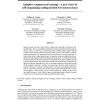11 search results - page 2 / 3 » Acquiring evolvability through adaptive representations |
TVCG
1998
13 years 5 months ago
1998
—Numerical simulation of physical phenomena is now an accepted way of scientific inquiry. However, the field is still evolving, with a profusion of new solution and grid-generati...
ICASSP
2010
IEEE
13 years 5 months ago
2010
IEEE
Sparse coding networks, which utilize unsupervised learning to maximize coding efficiency, have successfully reproduced response properties found in primary visual cortex [1]. Ho...
LWA
2007
13 years 7 months ago
2007
Typical conversational recommender systems support interactive strategies that are hard-coded in advance and followed rigidly during a recommendation session. In fact, Reinforceme...
E4MAS
2005
Springer
13 years 11 months ago
2005
Springer
Abstract. Even if the multi-agent paradigm has been evolving for fifteen years, the development of concrete methods for problem solving remains a major challenge. This paper focus...
VIS
2009
IEEE
14 years 6 months ago
2009
IEEE
Time and streak surfaces are ideal tools to illustrate time-varying vector fields since they directly appeal to the intuition about coherently moving particles. However, efficient ...

